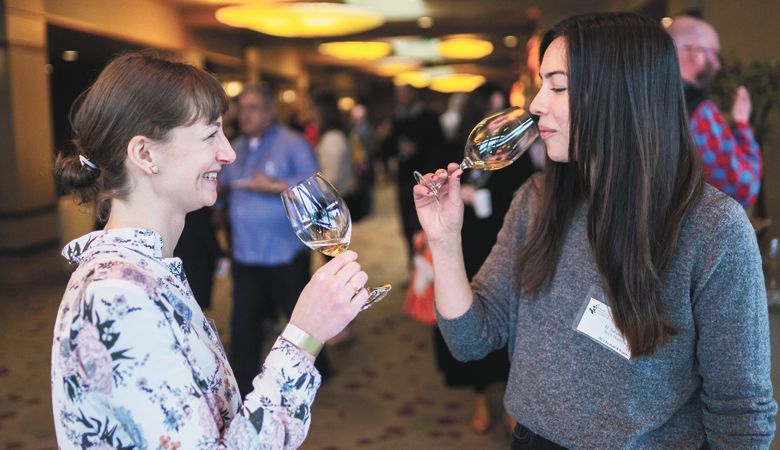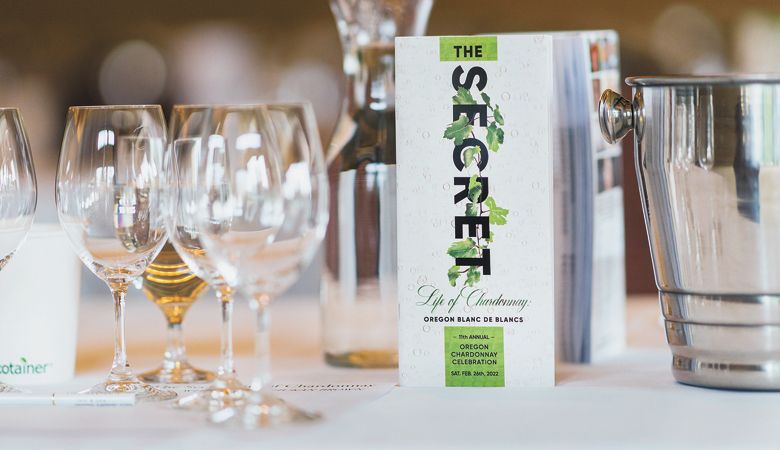Secret's Out
Chardonnay Celebration bubbles with excitement
The Secret Life of Chardonnay” proved an intriguing title for this year’s Oregon Chardonnay Celebration in late February. A play on popular movie titles — “The Secret Life of Walter Mitty,” “…of Bees, “…of Pets 1” and “…Pets 2” — the event showcased Chardonnay in its secret life as méthode Champenoise Blanc de Blancs.
Another title could have been “I Know What You Did Last Summer (with Chardonnay)” — horror movie reference too weird? When vintners are talking about “face-melting acid,” perhaps not.
Candid comments like these are what made this panel discussion — hosted inside the Allison Inn & Spa in Newberg — far more fun, hinting at the “secrets,” or complex choices, involved in making this ethereal wine style. Gina Hennen, winemaker at Adelsheim Vineyard in Newberg, summed it up. “For still wine, once you put it in the bottle, you are done. [With sparkling], there are still tons of decisions to make.”
“Face-melting acid” undoubtedly requires some context: Viticulturist Geoff Hall of Argyle Winery in Dundee used the term to describe tasting fruit to determine picking. When sampling ripe grapes, juicy, sweet pulp crosses the tongue after biting into skins that are full of texture. Not the case with grapes meant for sparkling. Vintners taste early, when the grapes are squeaky and young. Winemaker Jean-Michel Jussiaume of Maison Jussiaume in Southern Oregon explains that when tasting the grapes, one does not chew the underripe skins in order to save the palate and mimic the gentle pressing in the winery.
Richness in the pulp comes at the expense of acid. Phenolics (textures and tannins) in the skins will amplify through the winemaking process. They are tasting for the future. Is this the acidity and flavor profile they need to produce a wine that will encounter time on lees (yeast cells), two fermentations and aging? Jussiaume watches for a flavor progression as the grapes evolve from lime to lemon, apple, pear, and peach; he prefers harvesting between lemon and apple.
The evolution of acid happens extremely fast. Miss a day crushing grapes on your tongue, and the moment has likely passed — worse than an avocado. Picking bins have to be on site for the exact moment. Winemaker Kate Payne-Brown of Stoller Family Estate in Dayton says everybody is on call for sparkling wine harvest. “When the east winds howl (warm winds from the Gorge), I start to lose sleep and acidity.”
While vintners pick for style, the site determines the limit of that style. Some begin with a desired profile and plant a vineyard accordingly. These would be high-elevation, windy sites with some northern exposure, like Argyle’s Spirit Hill. Warmer sites require vintners to “lean in” to what the vineyard can deliver.
At the southern tip of the Dundee Hills, Payne-Brown identified the optimal vineyard sections for sparkling, taking her cue from Champagne producers who crop heavier and pick earlier. She says the site remains the “Paul Revere of the Dundee Hills” for picking sparkling. When she stages her bins, the other vineyards realize their time is coming soon. Winemaker Michael Davies — with associate winemaker Olivier Prost — of REX HILL in Newberg “leans in” to the natural, rich fruitiness and weight from Carabella Vineyard on Ladd Hill. He adjusts his pick time and fermentation vessels, embracing rich and textured, but classy and ageable.
Timing is essential for sparkling production, including aging on the lees. Winemaker Andrew Davis of Lytle-Barnett and The Radiant Sparkling Wine Co. in McMinnville takes a page from Champagne, which requires a minimum of 18 months on lees for non-vintage and three years for vintage wines. The timeframe allows for autolytic changes in which wines acquire yeasty, biscuit-like notes. “We see qualitative differences at these benchmarks used in Champagne making,” explains Davis. “With time, what once presented like lemon juice becomes creamy.” Of course, these are just standards. Through experimentation, Jussiaume follows a touchstone of three to five years on lees for “aromatics without being over-aged.” Most panel members craft an extended-tirage wine, meaning it remains on the lees for many years.
How long should wine age after disgorgement (removing lees) before release? It depends on the preferred style: younger or more developed. Under lees, wines change slowly as yeast is broken down. Davis explains that following disgorgement, the wine’s evolution speeds. He offers a visceral description: “Disgorgement is the first time the bottle has taken a breath.” A slow incursion of oxygen begins and the sparkling wine develops at the same rate as a still counterpart.
There is yet another factor: Before a bottle of Blanc de Blancs is corked and caged, it is dosed with a mixture of base wine and sugar (dosage) — another chance to affect the style of the finished wine. Those who attended the dosage trial at Argyle took a deeper dive into this topic. Guests tasted a Blanc de Blancs 2016 from Spirit Hill Vineyard with increasing doses of a sugar-wine mixture, from zero to six grams. Argyle’s winemaker, Nate Klostermann, instructed everyone to concentrate on differences in tightness, body and length. He explains how higher dosage sits on top of the base, masking aroma and flavor, while lower dosage reveals yeasty notes. He looks for what he calls the “Goldilocks,” or “sweet spot” of dosage. Once finished, it takes some time for the wine to bounce back from the dosage experience. This time also varies according to the vintner’s style.
How do vintners predict the future of sparkling wine? Experience is everything. Hennen admits, “It was like learning the winemaking process all over again.” Starting in 2005 as an intern and becoming a winemaker in 2013, Klostermann learned to trust the instincts that have soaked into his palate and brain. When asked if he still records the data, the answer was affirmative, but “I just don’t reference them as often.”
The secret is out: The future of sparkling wine shows great potential in Oregon. Davis agrees, describing the style here as “more fruit-forward than Europe and poised to be equally iconic.”












